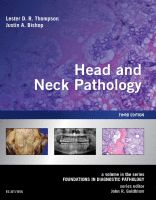Physical Address
304 North Cardinal St.
Dorchester Center, MA 02124

■ Paraganglioma Extra-adrenal paragangliomas arise from paraganglia distributed along the paravertebral sympathetic and parasympathetic chains and include tumors arising in the carotid body, jugulotympanic body, orbit, nasopharynx, larynx, vagal body, paraspinal chain (aorticosympathetic and visceral-autonomic), urinary bladder, and the organ…

■ Parathyroid Carcinoma Parathyroid carcinoma is a malignant neoplasm arising from the parathyroid parenchymal cells, comprising approximately 1% of all primary hyperparathyroidism (HPT) cases (no malignant adipose tumors are recognized in the parathyroid). Secondary parathyroid hyperplasia and neck irradiation are…

■ Parathyroid Adenoma A parathyroid gland adenoma is an encapsulated benign neoplasm of the parathyroid parenchymal cells (either chief or oncocytic cells). Parathyroid disease is separated into primary, secondary, or tertiary, based on whether the parathyroid gland is primarily the…

■ General Considerations There are a variable number of glands (2 to 10), but usually four are present, symmetrically arranged within the upper and lower poles of the bilateral thyroid gland. Approximately 5% of people have more than four glands.…

Thyroid gland malignancies account for about 3% of all cancers (13.5/100,000 population), while representing the most common malignancy of the endocrine system. In general, thyroid cancer afflicts young to middle-aged adults with environmental, genetic, and hormonal factors often playing an…

▪ Follicular Adenoma Follicular adenoma (FA) is a benign encapsulated neoplasm of follicular epithelial origin and is the most common neoplasm of the thyroid gland. Autopsy studies show that 3% to 5% of adult thyroid glands harbor an FA. A…

■ Thyroglossal Duct Cyst The thyroglossal duct represents the tract in the midline neck through which the thyroid anlage descends during embryonic development. It begins at the foramen cecum at the base of the tongue, continues around the hyoid bone,…

■ Metastatic Squamous Cell Carcinoma Metastatic squamous cell carcinoma (SCC) in the neck often presents without a clinically apparent primary. The majority of cases of metastatic SCC to cervical lymph nodes are associated with high-risk human papillomavirus (HPV) from the…

▪ Lymphangioma (Cystic Hygroma) Lymphangiomas are rare congenital lymphatic malformations, with up to 70% reported in the head and neck. They are separated into three types: capillary, cavernous, and cystic (cystic hygroma). Lymphangiomas comprise approximately 25% of all vascular neoplasms…

Non-neoplastic lesions of the neck can be broadly classified into developmental cystic anomalies; infections and related diseases/lesions; and reactive, inflammatory, and tumor-like lesions. ■ Branchial Cleft Anomalies Branchial cleft anomalies are divided according to the branchial apparatus involved and are…